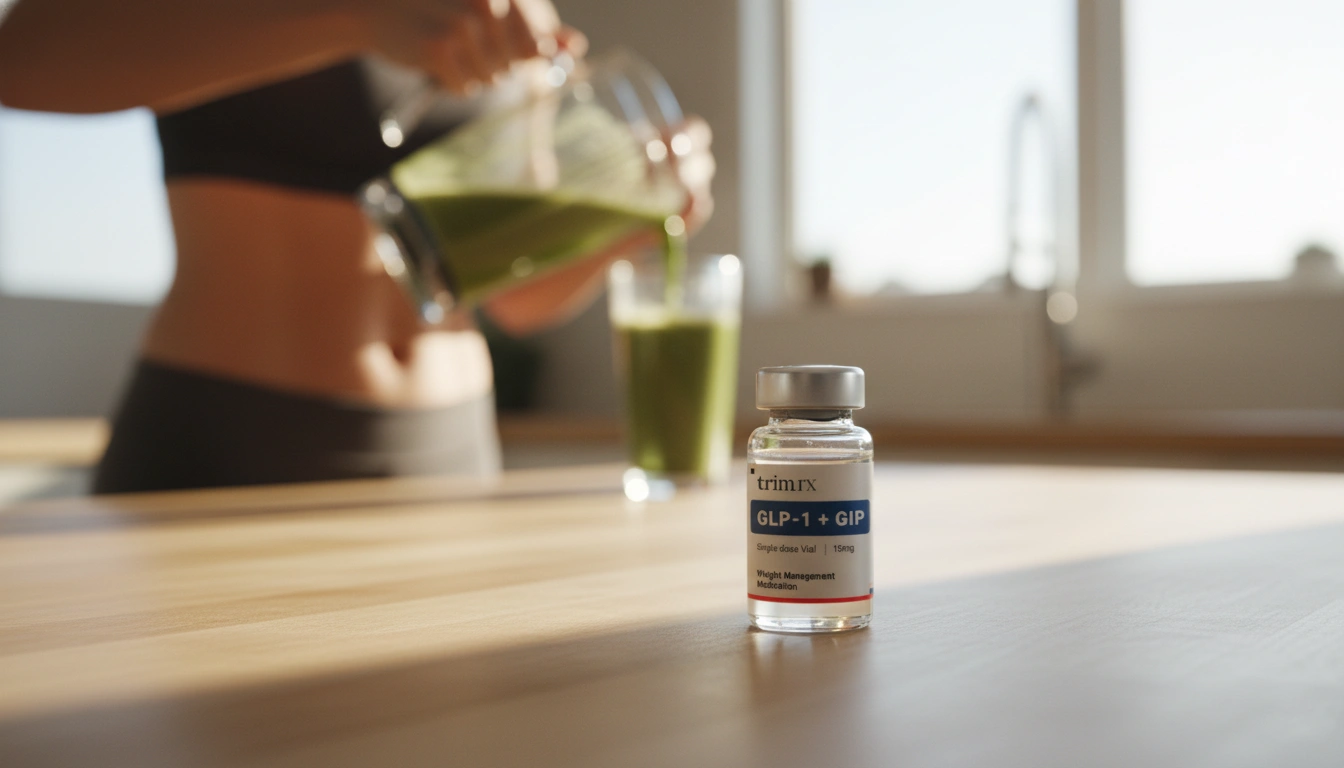What Foods Are High in GLP-1: A Comprehensive Guide

Introduction
Did you know that the food you consume can significantly influence the levels of a hormone that plays a crucial role in managing your appetite and blood sugar levels? This hormone, known as glucagon-like peptide-1 (GLP-1), is gaining attention in the realm of nutrition and weight management. With the rising prevalence of obesity and type 2 diabetes, understanding how to naturally boost GLP-1 levels through diet is not just interesting—it’s essential for many individuals striving for better health.
GLP-1 is produced in the gut and releases in response to food intake, helping regulate blood sugar by stimulating insulin secretion while inhibiting glucagon release, which raises blood sugar levels. This multifaceted hormone also slows gastric emptying, contributing to feelings of fullness. In this blog post, we will explore what foods are high in GLP-1, the underlying mechanisms that promote its secretion, and how these foods can play a role in your weight loss journey.
At TrimRx, we are dedicated to providing personalized, clinically proven weight loss solutions that merge medical science with compassionate care. We believe that sustainable weight loss should be achievable through a combination of effective medications and a healthy diet. By the end of this article, we aim to equip you with actionable insights on dietary choices that could enhance your GLP-1 levels, helping you manage weight effectively.
Scope of the Article
In this detailed exploration, we will cover:
- The role of GLP-1 in the body
- Foods that can naturally increase GLP-1 secretion
- The impact of dietary fiber and healthy fats on GLP-1 levels
- Sample meal ideas that incorporate GLP-1-boosting foods
- Practical tips for integrating these foods into your daily diet
As we delve into these topics, we invite you to consider how your current eating habits may align with these findings and how they can be adjusted to support your health goals. Let’s embark on this journey together to uncover the power of nutrition in enhancing GLP-1 levels.
The Role of GLP-1 in the Body
GLP-1 is a hormone produced by specialized cells in the intestines, primarily in response to nutrient intake. It has several important functions:
-
Stimulates Insulin Secretion: After a meal, GLP-1 promotes the release of insulin from the pancreas, which helps lower blood sugar levels by facilitating the uptake of glucose into cells.
-
Inhibits Glucagon Release: GLP-1 suppresses the release of glucagon, a hormone that increases blood sugar levels. This dual action helps maintain balanced blood sugar levels.
-
Slows Gastric Emptying: By delaying the rate at which food leaves the stomach, GLP-1 contributes to increased satiety and helps control appetite.
-
Reduces Appetite: GLP-1 acts on the brain to signal fullness, which can help reduce overall food intake and support weight management.
Given these critical functions, increasing GLP-1 levels through dietary choices can be a beneficial strategy for those looking to manage weight or blood sugar levels.
Foods That Can Naturally Increase GLP-1 Secretion
Certain foods have been shown to promote the secretion of GLP-1. These typically include foods rich in protein, fiber, and healthy fats. Here’s a breakdown of some of the most effective food sources:
1. High-Fiber Foods
Dietary fiber plays a pivotal role in stimulating GLP-1 secretion. Soluble fibers, in particular, can be fermented by gut bacteria to produce short-chain fatty acids (SCFAs), which are known to boost GLP-1 levels. Here are some high-fiber food sources to consider:
-
Whole Grains: Foods such as oats, barley, and whole wheat are rich in soluble fiber, which can enhance GLP-1 secretion. The fermentation of these fibers in the gut leads to increased SCFAs, which stimulate GLP-1 release.
-
Fruits: Certain fruits are excellent sources of soluble fiber, including apples, pears, and citrus fruits. Incorporating these into your diet can offer both nutritional benefits and support GLP-1 levels.
-
Vegetables: Leafy greens, carrots, and cruciferous vegetables like Brussels sprouts and broccoli are also high in fiber and can positively influence GLP-1 secretion.
2. Protein-Rich Foods
Protein is another nutrient that can stimulate GLP-1 release. Foods that are particularly beneficial include:
-
Eggs: A rich source of protein and healthy fats, eggs have been shown to promote GLP-1 secretion. Research indicates that meals containing eggs can lead to lower blood sugar levels and increased feelings of fullness compared to carbohydrate-rich meals.
-
Lean Meats: Chicken, turkey, and fish provide high-quality protein that can enhance GLP-1 levels. These foods can be particularly effective when consumed in balanced meals.
-
Plant-Based Proteins: For those on a plant-based diet, options such as beans, lentils, nuts, and tofu are excellent sources of protein that can also support GLP-1 levels.
3. Healthy Fats
Incorporating healthy fats into your diet can also stimulate GLP-1 secretion. Some sources of healthy fats include:
-
Avocado: Rich in monounsaturated fats and fiber, avocados can enhance GLP-1 levels while providing a satisfying texture and flavor to meals.
-
Nuts and Seeds: Almonds, walnuts, and chia seeds are packed with healthy fats, protein, and fiber, making them an ideal snack or addition to meals to help boost GLP-1.
-
Olive Oil: Unsaturated fats, like those found in olive oil, have been shown to promote GLP-1 secretion more effectively than saturated fats.
The Impact of Dietary Fiber and Healthy Fats on GLP-1 Levels
The relationship between dietary choices and GLP-1 secretion is complex but essential for understanding how to harness the power of food in managing appetite and blood sugar levels.
The Role of Fiber
As previously mentioned, fiber, particularly soluble fiber, plays a significant role in stimulating GLP-1. When fiber is fermented in the colon, it produces SCFAs, which bind to receptors in the gut, resulting in increased GLP-1 secretion. Some studies suggest that diets high in fermentable fibers can lead to improved satiety and weight management.
The Role of Healthy Fats
Healthy fats can also influence GLP-1 levels. Unsaturated fats, particularly those found in plant sources, may enhance the secretion of GLP-1 more effectively than saturated fats. For example, including olive oil in meals can not only add flavor but also contribute to increased GLP-1 levels, supporting better appetite regulation.
Sample Meal Ideas Incorporating GLP-1-Boosting Foods
If you’re looking to increase your intake of GLP-1-boosting foods, consider these meal ideas:
Breakfast
-
Avocado Toast: Whole-grain toast topped with smashed avocado, a poached egg, and a sprinkle of chia seeds.
-
Oatmeal Bowl: Steel-cut oatmeal topped with sliced apples, walnuts, and a drizzle of honey for sweetness.
Lunch
-
Quinoa Salad: A salad made with quinoa, chickpeas, diced vegetables, and a dressing of olive oil and lemon juice.
-
Vegetable Stir-Fry: A mix of broccoli, carrots, and bell peppers stir-fried with tofu and served over brown rice.
Dinner
-
Baked Salmon: Salmon fillet baked with herbs, served with roasted Brussels sprouts and a side of quinoa.
-
Chickpea Curry: A hearty chickpea and spinach curry served with brown rice or whole-grain naan.
Snacks
-
Nut Mix: A blend of almonds, walnuts, and seeds as a nutritious snack option.
-
Hummus and Veggies: Sliced carrots, cucumbers, and bell peppers served with hummus for dipping.
Practical Tips for Integrating GLP-1-Boosting Foods into Your Diet
-
Plan Your Meals: Incorporate a variety of GLP-1-boosting foods into your weekly meal plan to ensure balanced nutrition and sustained GLP-1 levels.
-
Prioritize Whole Foods: Focus on whole grains, fresh fruits, and vegetables, lean proteins, and healthy fats to create nutrient-dense meals.
-
Mindful Eating: Pay attention to your hunger cues and practice mindful eating, allowing you to recognize feelings of fullness and satisfaction.
-
Stay Hydrated: Drinking enough water can help control appetite and support overall health.
-
Get Support: If you’re considering dietary changes, it might be helpful to consult a registered dietitian who can provide personalized guidance and support.
Conclusion
Incorporating foods that naturally boost GLP-1 levels can be a powerful strategy for managing weight and improving overall health. By focusing on high-fiber foods, lean proteins, and healthy fats, you can enhance your body’s ability to regulate appetite and blood sugar levels.
At TrimRx, we believe that combining effective dietary practices with personalized, clinically proven weight loss solutions can lead to sustainable health outcomes. As you embark on your journey, remember that small changes in your diet can make a significant impact on your well-being.
FAQ
What are some other benefits of increasing GLP-1 levels?
Increasing GLP-1 levels not only helps with appetite regulation and blood sugar control but may also support weight loss and decrease the risk of type 2 diabetes.
Can I rely solely on diet to increase my GLP-1 levels?
While dietary changes can significantly enhance GLP-1 secretion, it’s essential to consider a holistic approach that may include medical interventions if necessary, especially for those with obesity or diabetes.
How quickly can I see results from dietary changes?
Results may vary; however, many individuals notice changes in appetite and satiety within a few weeks of consistently incorporating GLP-1-boosting foods into their diet.
Are there any foods I should avoid to support GLP-1 levels?
Highly processed foods and those high in saturated fats may hinder GLP-1 secretion and should be limited in a diet designed to promote healthy levels.
How can I test if my GLP-1 levels are adequate?
Consulting with a healthcare professional can provide insights into your metabolic health, including whether GLP-1 levels may be influencing your weight management efforts.

Transforming Lives, One Step at a Time
Keep reading
7 Tips for Sticking to GLP-1 Injection Schedules
Seven practical strategies to keep weekly GLP‑1 injections on schedule—pick a routine day, set reminders, manage side effects, rotate sites, and avoid missed doses.
Custom GLP-1 Dosing for Kidney Disease
Personalized GLP-1 dosing for CKD patients with monitoring, dehydration and hypoglycemia risk mitigation, and guidance across all kidney disease stages.
Semaglutide vs Tirzepatide: Approved Uses
Two leading diabetes and weight-loss drugs differ in FDA-approved benefits — one adds heart, kidney and liver protection; the other treats obstructive sleep apnea.



